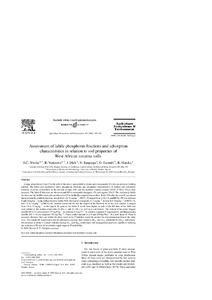| dc.contributor.author | Nwoke, O.C. |
| dc.contributor.author | Vanlauwe, Bernard |
| dc.contributor.author | Diels, J. |
| dc.contributor.author | Sanginga, N. |
| dc.contributor.author | Osonubi, O. |
| dc.contributor.author | Merckx, R. |
| dc.date.accessioned | 2019-12-04T11:23:49Z |
| dc.date.available | 2019-12-04T11:23:49Z |
| dc.date.issued | 2003-12 |
| dc.identifier.citation | Nwoke, O.C., Vanlauwe, B., Diels, J., Sanginga, N., Osonubi, O. & Merckx, R. (2003). Assessment of labile phosphorus fractions and adsorption characteristics in relation to soil properties of West African savanna soils. Agriculture, Ecosystems & Environment, 100(2-3), 285-294. |
| dc.identifier.issn | 0167-8809 |
| dc.identifier.uri | https://hdl.handle.net/20.500.12478/4167 |
| dc.description.abstract | A large proportion of total P in the soils of the area is unavailable to plants and consequently P is the second most limiting nutrient. The labile and moderately labile phosphorus fractions and adsorption characteristics of surface and subsurface horizons of eleven soil profiles in the derived savanna (DS) and the northern Guinea savanna (NGS) of West Africa were assessed. The labile P fractions are the resin and HCO3-extractable inorganic (Pi) and organic (Po) P. The moderately labile fractions are the NaOH-extractable portion of soil P in the Hedley sequential procedure. In the DS soils, the resin P, considered the most readily available fraction, varied from 1 to 14 mg kg−1, HCO3-Pi ranged from 3.3 to 11, and HCO3-PO was between 4 and 12 mg kg−1 in the surface horizon. In the NGS, the topsoil contained 1.5–3 mg kg−1 of resin P, 5–8 mg kg−1 of HCO3-Pi, and 7.5–9.7 mg kg−1 of HCO3-Po. Sodium hydroxide-Po was the largest of the fractions in all the soils studied. It ranged from 23 to 55 mg kg−1 in the topsoil. In general, the labile P levels were higher in soils of the DS than of the NGS and were related to the oxalate-extractable Fe (Feox), and Al (Alox) as well as to soil texture. The subsoil of Kasuwan Magani (profile KS 9–21 cm) required 153 mg P kg−1 to maintain 0.2 mg P l−1 in solution (standard P requirement), and Danayamaka (profile DD 7–32 cm) required 145 mg P kg−1. These could translate to 214 and 200 kg P ha−1 if a plow layer of 10 cm is assumed. Because these are within the plow layer, more P fertilizer would be needed for crop production than in the other soils. The standard P requirement and the adsorption maxima were related to Feox and Alox, dithionite-Fe (Fed), and texture. The increase in labile P content with decreasing Feox and Alox could imply that management practices capable of reducing the activities of Fe and Al in solution might improve P availability. |
| dc.description.sponsorship | Directorate-General for Development Cooperation and Humanitarian Aid, Belgium |
| dc.language.iso | en |
| dc.subject | Phosphorus |
| dc.subject | Soil Properties |
| dc.subject | Savannas |
| dc.subject | Soil |
| dc.title | Assessment of labile phosphorus fractions and adsorption characteristics in relation to soil properties of West African savanna soils |
| dc.type | Journal Article |
| dc.type | Journal Article |
| dc.description.version | Peer Review |
| cg.contributor.crp | Maize |
| cg.contributor.crp | Roots, Tubers and Bananas |
| cg.contributor.affiliation | International Institute of Tropical Agriculture |
| cg.contributor.affiliation | University of Ibadan |
| cg.contributor.affiliation | Laboratory of Soil Fertility and Soil Biology, Belgium |
| cg.coverage.region | Africa |
| cg.coverage.region | West Africa |
| cg.coverage.country | Nigeria |
| cg.coverage.country | Benin |
| cg.coverage.country | Togo |
| cg.isijournal | ISI Journal |
| cg.authorship.types | CGIAR and developing country institute |
| cg.iitasubject | Soil Fertility |
| cg.accessibilitystatus | Limited Access |
| local.dspaceid | 99733 |
| cg.identifier.doi | https://doi.org/10.1016/S0167-8809(03)00186-5 |

